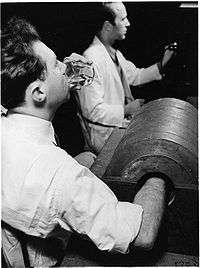Joseph Gilbert Hamilton
| Joseph Gilbert Hamilton | |
|---|---|
|
Joseph G. Hamilton drinking a radioactive sodium solution in 1939, with Robert Marshak to the right.[1] | |
| Born | November 11, 1907 |
| Died | February 18, 1957 (aged 49) |
| Nationality | United States |
| Fields | physics |
| Institutions | Lawrence Berkeley National Laboratory |
| Alma mater | University of California |
| Known for | medical effects of exposure to radioactive isotopes, unethical human experimentation |
Joseph Gilbert Hamilton (November 11, 1907 – February 18, 1957) was an American professor of Medical Physics, Experimental Medicine, General Medicine, and Experimental Radiology as well as director (1948-1957) of the Crocker Laboratory, part of the Lawrence Berkeley National Laboratory. Hamilton studied the medical effects of exposure to radioactive isotopes and he pioneered their use in the treatment and diagnosis of disease. He was married to the painter Leah Hamilton.
Hamilton received his B.S. in Chemistry in 1929 from the University of California. He studied medicine in Berkeley, and he interned at the University of California Hospital, San Francisco. He was awarded his M.D. degree in 1936. The cyclotron in Berkeley was then producing useful amounts of radioactive isotopes, and even before he received his degree, Hamilton became interested in their effects on living tissue. In a series of papers published in 1937 he detailed early medical trials using radiosodium, followed by papers detailing the use of the radioactive isotopes of potassium, chlorine, bromine, and iodine. Radioactive iodine was found to be particularly useful in the diagnosis and treatment of thyroid disorders.
Radioactive isotope studies
Hamilton's studies of isotope retention in humans, especially of radioactive strontium and the transuranic elements, were the principal source for the U.S. Atomic Energy Commission (AEC) estimates of tolerance limits of these substances. As part of the Manhattan Project in 1944, he and his research team began studies on the effect of plutonium in rats. Then, in secret trials conducted from 1945 to 1947, they injected plutonium into humans without their informed consent at the University of California Hospital at San Francisco. The human trials, which attempted to find the toxicity of plutonium in the human body, were terminated by the Atomic Energy Commission in 1950.
Albert Stevens, known as CAL-1, was a patient who received a dose of plutonium in 1945. Hamilton used Stevens as his first plutonium injection subject. Stevens had been misdiagnosed with terminal stomach cancer, but was later found only to have an ulcer. After the plutonium injection he survived the highest known accumulated radiation dose in any human, living 20 more years until his death at 79 years of age.[2] On May 14, 1945, he was injected with 131 kBq (3.55 µCi) of plutonium without his knowledge or informed consent.[3]
Hamilton also selected a baby, 4-year-old bone cancer patient Simeon Shaw, and 36-year-old Elmer Allen for plutonium injections.[2] Allen would live until he was 80, but died shortly before Pulitzer Prize-winner Eileen Welsome discovered his whereabouts.[2] Shaw died within a year of the injection from terminal bone cancer.[3]
The "Buchenwald touch" memo
Once the AEC took over control of the Manhattan Project's various roles, Hamilton returned to his work at Berkeley. In a memo written in 1950, Hamilton gave some recommendations to the AEC's Director of Biology and Medicine, Shields Warren. Hamilton wrote that large primates like "chimpanzees ... [should] be substituted for humans in the planned studies on radiation's cognitive effects."[4] He further warned that by using humans the AEC would be open "to considerable criticism," since the experiments as proposed had "a little of the Buchenwald touch."[4] Dr. Eugene Saenger would be the one who carried out these experiments from 1960 to 1971 at the University of Cincinnati, exposing "at least 90 cancer patients to large radiation doses."[5][6]
Death and legacy
Hamilton died at the age of 49 of radiation induced leukemia. His name was added to the Monument to the X-ray and Radium Martyrs of All Nations erected in Hamburg, Germany.
Notes
- ↑ "LBNL Image Library -- Collection Berkeley-Lab/People/Individuals: Joseph Hamilton drinking radiosodium" (text from the Fall 1981 issue of LBL Newsmagazine)
- 1 2 3 Welsome, Eileen (1999). The Plutonium Files:America's Secret Medical Experiments in the Cold War (PDF). Dial Press. ISBN 0385314027. Retrieved 18 November 2012.
- 1 2 Moss, William; Eckhardt, Roger (1995). "The Human Plutonium Injection Experiments" (PDF). Los Alamos Science. Radiation Protection and the Human Radiation Experiments (23): 177–223. Retrieved 13 November 2012.
- 1 2 "The Media & Me: [The Radiation Story No One Would Touch]", Geoffrey Sea, Columbia Journalism Review, March/April 1994.
- ↑ "Eugene Saenger, Controversial Doctor, Dies at 90," William Dicke, New York Times, October 11, 2007
- ↑ Thomas H. Maugh, "Eugene Saenger, 90; pioneer in radiation research",Los Angeles Times, October 6, 2007
References
- Moss, William & Eckhardt, Roger (1995) The Human Plutonium Injection Experiments, Los Alamos Science 23, 177-233;
- Welsome, Eileen (1999) The plutonium files: America's Secret Medical Experiments in the Cold War Dial press, New York. ISBN 0-385-31402-7 ;
- "James Gilbert Murdoch Hamilton". Lancet. ENGLAND. 2 (7769): 189–90. July 1972. doi:10.1016/s0140-6736(72)91365-7. ISSN 0140-6736. PMID 4114093.
- LAWRENCE, E O; GARRISON W M (August 1957). "J.G. Hamilton, medical physicist and physician". Science. 126 (3268): 294. doi:10.1126/science.126.3268.294. ISSN 0036-8075. PMID 13454816.
External links
- "In Memoriam: Joseph Gilbert Hamilton" University of California 1959;
- "Joe Hamilton's Cavalier Approach to Radiation" comments by Dr. John W. Gofman, December 20, 1994 at the Wayback Machine (archived September 25, 2007);
- "The Lawrence Berkeley Laboratory's Archives and Records Office's Role in the US Department of Energy's Human Radiation Experiment Records Search and Retrieval Project" by Lori L. Hefner STAMA Australia Newsletter No. 2, September 1995 at the Wayback Machine (archived July 30, 1997);
